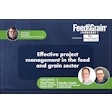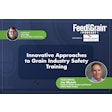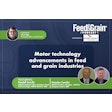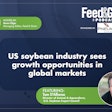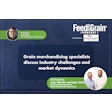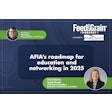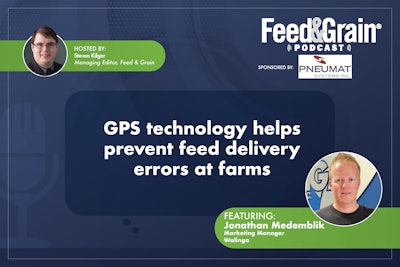
In this episode of the Feed & Grain Podcast, host Steven Kilger interviews Jonathan Medemblik marketing manager at Walinga, on GPS location matching systems for feed delivery trailers. The technology assigns unique GPS coordinates to each bin on a farm, then uses geofencing to ensure feed compartments in the trailer only unload at their assigned destinations. The system, which can be integrated into existing trailers and mill software, maintains delivery records while still allowing manual overrides when necessary, potentially preventing costly errors such as contaminating organic flocks or delivering medicated feed to the wrong animals.
Hello, my name is Steven Kilger, and I'm the managing editor of Feed & Grain Magazine and the host of the Feed & Grain Podcast. Thank you so much for joining me today as we dive deep into the issues affecting the feed manufacturing, grain handling and allied industries.
Jonathan Medemblik - 01:15
Yes, it's been a while.
Kilger - 01:17
But for anyone who might not be familiar with you, can you tell me a little bit more about yourself and what you do, and kind of your relationship to the whole industry?
Medemblik - 01:27
My name is Jonathan Metamblek. I'm the marketing manager for Walinga Incorporated. We build a complete line of feed and grain equipment. Of course, our bulk feed trailers, right, and then our pneumatic conveying systems for the feed and grain industry. Been the marketing manager for quite some time. It's our family business, so it's, yeah, it's come a long ways over the last, actually, we just celebrated our 70th anniversary last year, so come a long way, things have been good.
Kilger - 01:56
Yeah, it's always nice to see a family business still doing it after 70 years. But you're here today to talk about a new technology that you guys have been launching on your trailers, you've been using for a while. It's using GPS location matching to make sure that your feed bodies are matched up to the location they need to be in the bin they need to do deliveries. Can you tell me a little bit more about what GPS location matching is and how adding it to feed bodies has really helped to kind of address some pain points in the industry?
Medemblik - 02:28
Yeah, for sure. So, this has been something that has kind of been an issue for quite some time. And over the last number of years, we've kind of been looking at ways to mitigate this issue by delivering the wrong feed to the wrong bin. So yeah, I guess as far as the GPS location matches, matching works is, of course, we all know it can be relatively easy and common for feed deliveries to be confused or mixed up from time to time, right, between intended delivery destinations and what have you. Human error is a very real thing. You can have new drivers changing routines and things like that. People covering for other people, mistakes happen.
So things can get disrupted. There are all kinds of different factors that could be involved with different errors being made. Potentially tons of feed could be put into the incorrect destination bin. So, things like that can, they can, they can devalue. Organic flocks, medication can get into the wrong animals, all that kind of stuff. So, I guess another thing would be, yeah, at the very least, delivering mistakes often requires the mill to have to go and retrieve it, right, and then put the correct feed in the bin.
Kilger - 04:15
Yeah, and that's the best-case scenario. Like you said, giving medicated feed to the wrong animals could cause a big issue if you're not careful. So just having to go and get it and having the time loss and everything seems like the best-case scenario. Can you tell me then how this technology works? How does it stop someone from delivering or unloading that feed into the wrong bin or the wrong farm, or the wrong location?
Medemblik - 04:43
The way it works is obviously, GPS coordinates are extremely accurate. So, what we do is each destination, so each farm has multiple or can have multiple bins on that farm. So, each bin actually has a GPS coordinate. So the top of that bin can have the potential to have very unique GPS coordinates. So, using geofencing, established around that area, that destination, basically we can map the top of the bin to a GPS coordinates. So, then at the mill with the software we can determine, okay, this bin has these GPS coordinates, and then you can assign the bin inside the trailer to only unload at that specific bin on the farm. So, this can prevent human error from accidentally opening the wrong compartment or gate in a trailer at the wrong destination.
So what we do is the first time a trailer with this technology goes to a location, you actually train the GPS location with the boom position to the top of the bin, and give each bin unique GPS coordinates. So, back at the mill, when they fill that trailer, they can assign the pockets on the trailer to certain GPS locations.
Kilger - 06:01
It's weird because GPS has been around for so long now, and you don't really like to think about advancements in that technology, but you are right. It's much more accurate than it used to kind of makes something like this possible.
Medemblik - 06:14
Yeah. And actually, when we first started dabbling in this, we didn't even use GPS; we were using RFID tags. So there was that technology, which is not nearly as accurate as GPS is so back when we started doing all this with the RFID thing it was it was pretty cool, but now with GPS, we can be even more accurate.
Kilger - 06:35
Yeah, as you were saying, just like the boom over the bin, being able to mark that location. That seems incredibly neat on this point. I didn't realize that stuff, I mean, Google Maps can't even get my car face in the right direction at first.
Medemblik - 06:50
Yeah, so like I said, when we go out on the first trip, the GPS receiver on the end of the boom on the trailer when it's over top of let's say bin A that has a very unique GPS location it's very different than compared to the top of bin B which is which can be another 80 to 100 feet over right that top of that bin when that boom is over top of it is at a totally different GPS location, so we basically we train it and we map it all out it all goes into the software back. Well, and this technology must also help in other ways.
Kilger - 07:24
Beyond just wrong deliveries. I imagine the record-keeping ability would be great. You now know exactly when a vehicle was at a bin in unloading versus before, where you kind of had to take everyone's word for it.
Yeah, so now they have records of every single load, each pocket inside the trailer, which bin it went into on the farm. They have all these records that they can go back and keeps very good track of all that stuff.
Kilger - 07:50
So, if someone's interested, what is the setup like? So, can you get it involved in feed bodies you already have? Do you need new equipment when someone buys it? Do they set it up on their own? How does all that work?
Medemblik - 08:03
Yeah, we can integrate it into existing trailers. It's basically the hardware inside the controls inside the control box, the trailer, and then obviously you've got your GPS sensor positioning on the boom, and then the software back at the mill that keeps track of all the information to it. Also it is integrated very well with existing mill software so it's pretty painless and like I said before, once you start to use it, you basically you have every time you go to a facility or a farm, you have to map that you have to train the trailer on that farm to the specific bins that it's going to. And it only has to be done once per farm, so after it's been trained on that farm, you can do the next one, and then it retains all that information for later trips.
Kilger - 08:51
Yeah, and you can train as many bins as you want. The date is there, so if you have a hundred farms you deliver to, you can train for each one, right?
Medemblik - 08:59
Yep, that is correct.
Kilger - 09:00
Awesome and what if say the driver still has full control though right if they need to manually override if they need to do something it allows them to do it does it then like keep track of when you had to do that so you know exactly what's going on in the bin which seems like one of the coolest features to me is the fact that this whole thing is just you can now know exactly how your feeds being delivered but the driver still in full control though right they can do a manual override they can do that kind of thing There are different security measures in place, right?
Medemblik - 09:31
Obviously, things like this have to come with manual overrides because human error is still a thing. load the trailer at the mill, and the software and person that's assigning the loads to that trailer can make a mistake, and there is still the ability for the driver, let's say the driver gets to the farm, and then there's an issue with the GPS location, and it won't unload or something like that. They can easily get in touch with either the fleet manager or dispatcher, or whoever, to get a unique code that they can get in and unlock, and then be able to continue on with their delivery at that destination. And then everything can be relocked as well for the rest of the trip. So, it's all kinds of those fail-safes and things like that that are built into too. So, and then all your load reports are automatically updated to a database, you can look at what actually went where and what went wrong.
Kilger - 10:24
Excellent. Yeah, that's the perfect level of technology, right? I want to assist, but I want to still feel like I'm in control. Does it integrate with other software? You mentioned all the data goes back. Is it proprietary software that you guys have? Can people integrate it with their client management systems? How does that work?
Medemblik - 10:43
Yeah, so most feedmill management software systems and truck loading systems can implement modules of their software system to automatically pass required data packages to the trailer. Each time the feed is loaded, it avoids the need for extra work for a whole different system to put data entry into.
So it can be worked into existing systems.
Kilger - 11:40
Finally, a good reason to expand your Wi-Fi network at your mill. I'm sure everybody will enjoy that. This seems like a really cool piece of technology and part of this package of, at least the way I think about it, which is more efficient mills. That's how we save money going in the future, right? We're more efficient, we're more accurate, we're better at record keeping, we're doing all that stuff. Looking at the future ... what enhancement, what additional features are you developing for your system? What do you guys see coming down the pipeline of, well, really, you're the experts on the future of feedbody technology?
Medemblik - 12:14
The whole feedlock thing is very important to customer service and being more efficient, and that kind of thing, right? We're, of course, always looking at ways to make this better. We spend a lot of time consulting with our customers on feedback, especially with those who are using this feedlock technology in the field. How can we make it better to... We're looking at different ways to make the user interface better, different features based on customer feedback.
Kilger - 13:07
Well, that sounds exciting. So, anyone who's interested out there, where should they go to find more information?
Medemblik - 13:13
Yeah, so a lot of the information on our feed trailers and our Feedlock systems could be found on our website, at walinga.com. We've also got a pretty good social media presence. A lot of our social media accounts can be accessed through our website.
Check us out on YouTube as well. Also, at a number of different trade shows that we attend that a lot of this technology can be seen in person. So yeah, next shows that we'll be at are available on our website too. So come and stop by and check us out online.
Kilger - 13:45
Yeah, definitely. I know I will be at IPPE this year. I always love going and seeing the feed bodies. Some of the most exciting feed equipment is there.
Medemblik - 13:52
We always very much look forward to that show.
Kilger - 13:54
Well, Jonathan, thank you so much for joining me today. I hope you come back again to talk to us more. And everyone out there listening, thank you so much. And until next time, stay safe.








